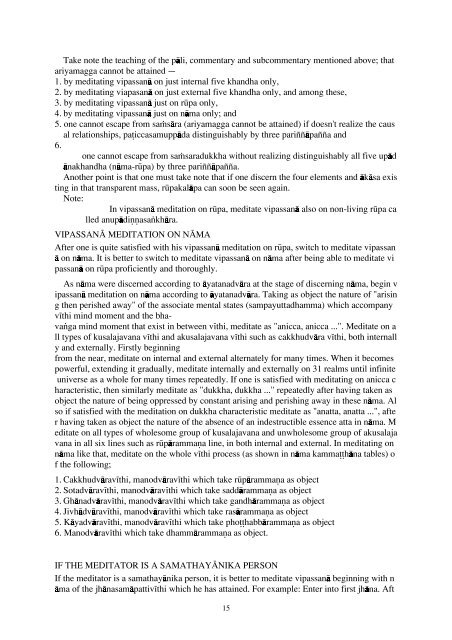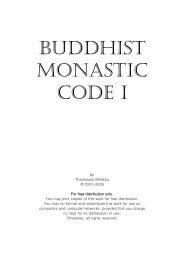Vipassana Kammatthana.pdf
Vipassana Kammatthana.pdf
Vipassana Kammatthana.pdf
You also want an ePaper? Increase the reach of your titles
YUMPU automatically turns print PDFs into web optimized ePapers that Google loves.
Take note the teaching of the påli, commentary and subcommentary mentioned above; that<br />
ariyamagga cannot be attained ---<br />
1. by meditating vipassanå on just internal five khandha only,<br />
2. by meditating viapasanå on just external five khandha only, and among these,<br />
3. by meditating vipassanå just on rËpa only,<br />
4. by meditating vipassanå just on nåma only; and<br />
5. one cannot escape from sa◊såra (ariyamagga cannot be attained) if doesn't realize the caus<br />
al relationships, pa iccasamuppåda distinguishably by three pariññåpañña and<br />
6.<br />
one cannot escape from sa◊saradukkha without realizing distinguishably all five upåd<br />
ånakhandha (nåma-rËpa) by three pariññåpañña.<br />
Another point is that one must take note that if one discern the four elements and åkåsa exis<br />
ting in that transparent mass, rËpakalåpa can soon be seen again.<br />
Note:<br />
In vipassanå meditation on rËpa, meditate vipassanå also on non-living rËpa ca<br />
lled anupådiˆˆasa∫khåra.<br />
VIPASSANÓ MEDITATION ON NÓMA<br />
After one is quite satisfied with his vipassanå meditation on rËpa, switch to meditate vipassan<br />
å on nåma. It is better to switch to meditate vipassanå on nåma after being able to meditate vi<br />
passanå on rËpa proficiently and thoroughly.<br />
As nåma were discerned according to åyatanadvåra at the stage of discerning nåma, begin v<br />
ipassanå meditation on nåma according to åyatanadvåra. Taking as object the nature of "arisin<br />
g then perished away" of the associate mental states (sampayuttadhamma) which accompany<br />
v¥thi mind moment and the bhava∫ga<br />
mind moment that exist in between v¥thi, meditate as "anicca, anicca ...". Meditate on a<br />
ll types of kusalajavana v¥thi and akusalajavana v¥thi such as cakkhudvåra v¥thi, both internall<br />
y and externally. Firstly beginning<br />
from the near, meditate on internal and external alternately for many times. When it becomes<br />
powerful, extending it gradually, meditate internally and externally on 31 realms until infinite<br />
universe as a whole for many times repeatedly. If one is satisfied with meditating on anicca c<br />
haracteristic, then similarly meditate as "dukkha, dukkha ..." repeatedly after having taken as<br />
object the nature of being oppressed by constant arising and perishing away in these nåma. Al<br />
so if satisfied with the meditation on dukkha characteristic meditate as "anatta, anatta ...", afte<br />
r having taken as object the nature of the absence of an indestructible essence atta in nåma. M<br />
editate on all types of wholesome group of kusalajavana and unwholesome group of akusalaja<br />
vana in all six lines such as rËpårammaˆa line, in both internal and external. In meditating on<br />
nåma like that, meditate on the whole v¥thi process (as shown in nåma kamma håna tables) o<br />
f the following;<br />
1. Cakkhudvårav¥thi, manodvårav¥thi which take rËpårammaˆa as object<br />
2. Sotadvårav¥thi, manodvårav¥thi which take saddårammaˆa as object<br />
3. Ghånadvårav¥thi, manodvårav¥thi which take gandhårammaˆa as object<br />
4. Jivhådvårav¥thi, manodvårav¥thi which take rasårammaˆa as object<br />
5. Kåyadvårav¥thi, manodvårav¥thi which take pho habbårammaˆa as object<br />
6. Manodvårav¥thi which take dhammårammaˆa as object.<br />
IF THE MEDITATOR IS A SAMATHAYÓNIKA PERSON<br />
If the meditator is a samathayånika person, it is better to meditate vipassanå beginning with n<br />
åma of the jhånasamåpattiv¥thi which he has attained. For example: Enter into first jhåna. Aft<br />
15






